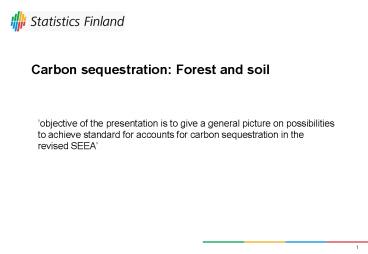Carbon sequestration: Forest and soil PowerPoint PPT Presentation
Title: Carbon sequestration: Forest and soil
1
Carbon sequestration Forest and soil
- objective of the presentation is to give a
general picture on possibilities to achieve
standard for accounts for carbon sequestration in
the revised SEEA
2
Introduction Greenhouse gas emissions and
removals from the LULUCF sector. Finland 2007.
Positive figures refer to emissions, negative to
removals
3
Land use, land use change and forestry (LULUCF)
in greenhouse gas reporting
- In reporting greenhouse gases according to the
UN climate convention and the Kyoto protocol, the
LULUCF category issub-divided into - Forest land,
- Cropland,
- Grassland,
- Wetlands,
- Settlements and
- Other land.
4
Forest land in greenhouse gas reporting
- The Forest land consists of
- 1. Forest land remaining forest land 1.1.
Managed (intensively/extensively) - 1.2. Natural, undisturbed
- 2. Land converted to forest land
- 2.1. Managed (intensively/extensively)
- 2.2. Natural, undisturbed
- The GHG reporting covers only managed forests.
Managed forests are subject to periodic or
ongoing human interventions.
5
Forest land in greenhouse gas reporting
- For the forests the key entity is annual change
in carbon stock. It is the sum of - Change in carbon stocks in living biomass
Increase due to above and below ground biomass
growth - - Decrease due to fellings, fuelwood gathering,
disturbances - Change in carbon stocks in dead wood and litter
- Change in carbon stocks in mineral and organic
soil - Equations to changes in carbon stocks of
cropland, grassland, wetlands, settlements and
other land are also available from the IPCC Good
Practice Guidance for LULUCF, as well as
instructions for calculations.
6
Annual change in carbon stock of forest and other
wooded land
7
IPCC Good Practice Guidance for LULUCF some
equations...
- Equation 3.2.31 Annual change in carbon stocks in
mineral soils in land converted to forest
land..... 3.62 - Equation 3.2.32 Annual change in carbon stocks in
mineral soils upon afforestation1
....................... 3.63 - Equation 3.2.33 CO2 emissions from drained
organic soils in land converted to forest
land............... 3.63 - Equation 3.3.1 Annual change in carbon stocks in
cropland remaining cropland.......................
....... 3.70 - Equation 3.3.2 Annual change in carbon stocks in
soils in cropland remaining cropland
................. 3.74 - Equation 3.3.3 Annual change in carbon stocks in
mineral soils for a single cropland system
......... 3.75 - Equation 3.3.4 Annual change in carbon stocks in
mineral soils in cropland remaining cropland ....
3.78 - Equation 3.3.5 CO2 emissions from cultivated
organic soils in cropland remaining cropland
.......... 3.79 - Equation 3.3.6 Annual carbon emissions from
agricultural lime application ....................
................ 3.80 - Equation 3.3.7 Total change in carbon stocks in
land converted to cropland .......................
............. 3.83 - Equation 3.3.8 Annual change in carbon stocks in
living biomass in land converted to cropland.....
3.85 - Equation 3.3.9 Change in carbon stocks as a
result of clearing biomass in a land use
conversion .... 3.86 - Equation 3.3.10 Carbon losses from biomass
burning, on-site and off-site ....................
..................... 3.86 - Equation 3.3.11 Carbon losses from biomass decay
..................................................
.......................... 3.87 - Equation 3.3.12 Annual change in carbon stocks in
soils in land converted to cropland...............
...... 3.89 - Equation 3.3.13 Total annual emissions of N2O
from mineral soils in land converted to
cropland..... 3.93
8
Carbon stock in the Global Forest Resource
Assessment (FRA)
- Information on carbon stock indicates the
contribution of Forest and Other wooded land to
the carbon cycle. It is used by international
processes that monitor greenhouse gases and
climate change. - Unit of reporting is Million metric tonnes.
Reported figures refer Area classified as Forest
and as Other wooded land. - Categories and definitions used in FRA correspond
to those by the Intergovernmental Panel on
Climate Change (IPCC). - Carbon content in biomass is usually derived
using conversion factors. Reported figures on
carbon stock are closely related to figures on
biomass stock and growing stock. - Conversion factors from timber and biomass stock
are not directly used for carbon stock changes of
the soil.
9
FRA categories of carbon stock
10
An example of conversion factors. Finland 2009.
11
Conclusions to be considered
- The GHG reporting on changes of carbon stocks
cover only managed forests. This category equals
to the FRA categories Other naturally regenerated
forest and Planted forest. - From the SEEA assets point of view, timber in
those above mentioned forest categories equals to
the SEEA asset category EA.1411 Cultivated
(timber resources). Changes in the carbon stock
of cultivated timber resources can directly be
derived from the FRA and GHG reporting on timber,
tree biomass and carbon. - For the SEEA asset accounts for forests, changes
in the stock of carbon in forests consisting of
Non-cultivated timber are as important as those
changes in forests consisting of Cultivated
timber. The scope of the SEEA exceeds the scope
of the GHG reporting framework.
12
Conclusions to be considered
- In general, changes in carbon stock of timber,
rest of wood biomass and forest soil can be
included into the SEEA asset accounts for
forested land and timber. - Rough estimates for annual opening and closing
stocks of carbon can be derived from data and
estimations on annual changes in stocks. - However, it should be considered whether full
balance sheets on carbon stocks are important for
the SEEA standard at this stage of the revision. - Changes in stocks offer the main information for
the decision making on optional uses of forests,
such as e.g. intensive timber production or
protection of forests to prevent climate change.

